This is topic Regular 8mm Sound??? in forum 8mm Forum at 8mm Forum.
To visit this topic, use this URL:
https://8mmforum.film-tech.com/cgi-bin/ubb/ultimatebb.cgi?ubb=get_topic;f=1;t=012002
Posted by Brian Hendel (Member # 61) on January 07, 2018, 07:57 PM:
Sitting here watching the Golden Globes AND a regular 8mm sound digest of Snow White Meets the Three Stooges released in 1965 by Americium - a home movie company located right here in New York City. I got to thinking.... how big of a regular 8mm sound marketplace was there back in 1965 (the year I was born btw)? Did people have regular 8mm sound movie cameras? It just seems like a really small niche of buyers. After all, super 8 had just come out. How many Regular 8mm sound consumers could there have been. What do you think?
Posted by Maurice Leakey (Member # 916) on January 08, 2018, 03:54 AM:
1965 was a bit of a disaster year for regular 8 films both silent and sound, because, as you say, this was the year that Kodak introduced Super 8 which forged ahead.
Posted by Allan Broadfield (Member # 2298) on January 08, 2018, 05:14 AM:
Back in 1965 home movie circles were alive with speculation over the new super 8 guage, and die hards were doubtfull about the benefits.
Main missgivings that i recall were the smaller sprocket holes, which many thought would be too prone to damage. Another feature that some were concerned about was the fact that the picture gate was partly situated in the cartridge itself.
I don't think these worries came to much, and as I was still single (but not for long!), I did the change and was impressed with the improvement, though I think that some of the old die hards might still disagree!
Posted by Brian Fretwell (Member # 4302) on January 08, 2018, 07:05 AM:
I don't remember there being any 8mm sound camera until Kodak introduced the Super 8 ones later. There were sync devices for running tape recorders with cameras and projectors, if I recall correctly, but as most standard 8 cameras were clockwork I think these were mainly for 16mm.
Posted by Buck Bito (Member # 2676) on January 08, 2018, 08:15 AM:
Most of the Regular-8mm sound film I see was striped after processing, but we occasionally see film from the Fairchild Cinephonic which was a sync-sound camera using film pre-striped from Fairchild, introduced in 1959. Kodaks's Super-8 Sound system did not come along until 1973.
See:
http://8mmforum.film-tech.com/cgi-bin/ubb/ultimatebb.cgi?ubb=get_topic;f=1;t=009568
Posted by Maurice Leakey (Member # 916) on January 08, 2018, 09:33 AM:
My standard 8 films were run on a Eumig P8 Imperial which had facilities for linking with a 1/4" tape recorder. The speed of the tape governed the speed of the projector to keep in reasonable sync, but not lip-sync.
Then came a Eumig S807D dual-gauge sound projector. When filming my wife carried a small cassette recorder for the sound. When the film was finally edited it was sent to have a stripe applied and on its return the cassette sound was added. But still not lip-sync, but quite acceptable.
Later, I bought a Bell & Howell Super 8 sound camera, it had a 30ft lead for the mic. And now, wow, lip-sync at last.
It was a bad day when Kodak announced that they were discontinuing pre-striped cartridges.
Posted by Joe Caruso (Member # 11) on January 08, 2018, 10:46 AM:
Std 8 Sound was still strong, even Blackhawk reported that sales in-demand were high, even at the outset of Super 8 they continued to offer Std 8 until a year or so later - I'm a die-hard advocate of Std 8 films, sound or silent, it is there the clarity and density of a print is wonderful to behold - Shorty
Posted by Oliver F. R. Feld (Member # 1911) on January 08, 2018, 10:58 AM:
My PSYCHO feature in STD8 is amazing and the soundstripe, too.
Better in picture quality than some Super-8-features.
Posted by Paul Adsett (Member # 25) on January 08, 2018, 02:17 PM:
Like Maurice, I had a Eumig P8 projector with the Phonomat tape synchronizer mounted on the back. It worked very well for music and commentary, but as Maurice points out, not good enough for lip sync.
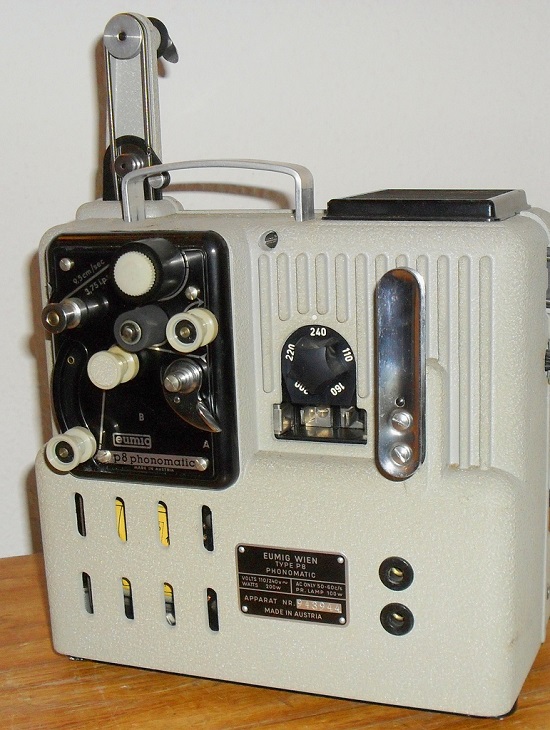
Here is the gorgeous looking CirseSound standard 8mm stripe sound projector from 1959. The 56 frames sound advance on this machine became the standard design for all future 8mm sound projectors.
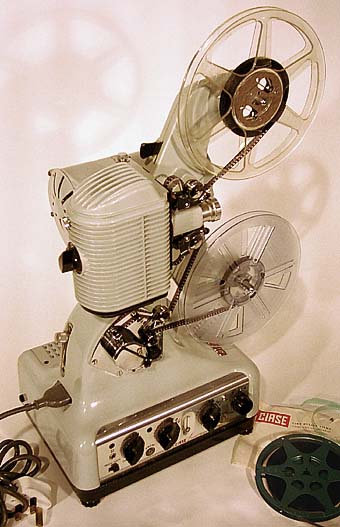
I am sure Joe is right about the superior print quality of some 8mm prints versus their super 8 counterparts. But, all things being equal, super 8mm prints of course have to be superior to 8mm prints.
For home movies though, as Alan has mentioned, a lot of people myself included, feel that reversal film shot in an 8mm camera looks better than super 8mm camera film, due to the precision of the all metal 8mm camera gate compared with the Kodak plastic super 8mm cartridge, and the superiority of prime lenses versus the zoom lenses fitted to Super 8mm cameras.
Posted by Allan Broadfield (Member # 2298) on January 08, 2018, 03:45 PM:
I dabbled with the P8 Phonomatic too, attempting to add roughly synced up music and sound effects to package movies.
Posted by Thomas Dafnides (Member # 1851) on January 08, 2018, 09:53 PM:
Fairchild made their line of Cinephonic 8mm standard sound cameras since 1959 as stated. These were of more robust construction quality than any Super 8 sound camera.
It is a shame that Kodak did not clue Fairchild into the development of Super 8 because in January 1965 (the same month Super 8 was annouced). Fairchild showed a new professional studio 200' sound standard 8mm camera with their revolutionary Hall Sensor recording system at Photokina. This camera as I recall was more impressive looking than any Super 8 sound camera that came later. The camera had the silhouette of a classic Hollywood Mitchell camera . I do not believe the camera ever went into production because of Super 8. If Kodak had revealed to Fairchild their Super 8 plan development , we would of had a 200' Double Super 8 sound camera in 1965. But, of course, then Fairchild would of had the lead in Super 8 sound camera production. Later in 1973, when Kodak introduced their Super 8 sound camera, it featured the Fairchild Hall Sensor recording system which they bought the patent rights for.
Also, in January 1965, Viewlex introduced an industrial Standard 8mm sound projector with large 800' or 1200' reels for educational classroom use. Only a few of these were manufactured because of Super 8.
[ January 09, 2018, 09:17 PM: Message edited by: Thomas Dafnides ]
Posted by Adrian Winchester (Member # 248) on January 10, 2018, 02:00 PM:
Fascinating to read about a Std 8 sound camera - I almost posted to say there was no such thing but I thought I'd better not underestimate the chances of learning something new here!
One notable indication of Std 8 surviving beyond the introduction of Super 8 is the Std 8 releases of films from the years after 1965. E.g. I have a Derann Std 8 b/w print of 'Scars of Dracula', released (in cinemas) in 1970. It appears to be full length, unlike their initial 4 x 400' Super 8 releases (long before the Super 8 full length version). I must get round to selling it sometime!
Posted by Brian Hendel (Member # 61) on January 10, 2018, 07:13 PM:
Adrian - I used to have that Standard 8 feature of Scars of Dracula, too. Once the full length super 8 version came out I sold it.
Going back to that original post - I guess the question is... what projector would people have used in 1965 to play the Regular 8mm Americium releases with the magnetic soundtracks? Did Eumig have a regular 8 sound projector out at the time?
Posted by Simon Wyss (Member # 1569) on January 11, 2018, 03:49 AM:
Eumig’s Mark S line was begun in 1966, the projector was made for both 8-R and 8-S film.
Before you had a number of projectors that were linked to a tape recorder by means of a synchronizer. The designations went from Synchromat to Sonorizer and the like. In that group we have Paillard-Bolex, Nizo, Noris, Eumig, Meopta, Zeiss-Ikon, Pathé, and more. Quarter-inch magnetic tape offers HiFi sound whereas 8mm COMMAG (combined with the film magnetic stripes) always deals with a very stiff material and a narrow track width.
One little group of equipment existed for the SEPMAG principle. The most prominent is the Siemens & Halske 800 that runs Regular-Eight film and identically perforated magnetic film parallel.
An interesting fact is that equal lengths are transported when we look at Regular-8 film at 25 f. p. s. and magnetic tape at 3¾ i. p. s., the perforation pitch being 0.15".
Posted by Dominique De Bast (Member # 3798) on January 11, 2018, 04:13 AM:
Heurtier also manufactured magnetic sound 8 mm projectors in the 50's.
Posted by Panayotis A. Carayannis (Member # 1220) on January 11, 2018, 05:30 AM:
In the fifties?? I thought standard 8 sound was introduced in 1960!!
Posted by Dominique De Bast (Member # 3798) on January 11, 2018, 06:22 AM:
Panayotis, since tri gauges sound projectors were available in the '50s, I assumed that 8 mm was also availble in sound. There is not a lot of informations about Heurtier, so maybe someone could confirm or infirm ?
Posted by Robert Crewdson (Member # 3790) on January 11, 2018, 07:18 AM:
When I got my first Derann catalogue in 1975, they still had some titles that were only available in Standard 8, I think 'Orders are Orders', a Tony Hancock film from 1954 was one of them, and the reason I didn't buy it. Since then, what few Standard 8 films I have seen have all looked superior to Super 8.
Posted by Buck Bito (Member # 2676) on January 11, 2018, 10:45 AM:
On the topic of offsets, I see the Eumig dual format machines cited in this thread, but my experience is that these machines had the Super-8 offset to the sound heads of 18 frames. Whereas the 8mm 'standard' was 56 frames (same length of film - 0.7ft - as the 28 frame 16mm magnetic offset), the normal threading of a Eumig dual such as a Eumig S-709 would have the sound over a second and a half early at 24fps. I don't think there were affordable audio delays in those days, so how did folks use the dual-format sound projectors for Standard-8 sound prints?
Asking as the owner of at least 4 true Standard-8 Sound projectors:
-Cirse-Sound
-Calvin Movie-Sound-8 (which appears to have a short offset)
-Kodak Sound-8
-Fairchild HLH-1 (which purportedly has its own offset of 52 frames - https://en.wikipedia.org/wiki/Standard_8_mm_film#Sound - I'm not sure we can trust wikipedia on that number)
[ January 11, 2018, 07:16 PM: Message edited by: Buck Bito ]
Posted by Robert Crewdson (Member # 3790) on January 11, 2018, 10:56 AM:
There was a guide attached to the gate of the Eumig projectors, and the regular 8 was longer to account for the difference in sound seperation.
Posted by Clive Casey (Member # 6202) on January 11, 2018, 11:53 AM:
When I started with 8mm back in the 60s, I used to hire standard 8mm films from a library called Filmland, I think it was based in London. Derann took Filmland over so I used to hire standard 8 from Derek. I went to the shop in the 60s, It was on Stourbridge Road then. In the back room they had a 16mm projector set up with a flexible drive running to 2 8mm machines to transfer the sound.
Super 8 came out and Derann started super 8 as well as standard 8. If my memory serves me correct, they had a lot of trouble in the early days with scratching. I think this was due to the early projectors not having a feed sprocket. I think Derann nearly pulled out of super 8 and concentrated on standard 8, but I could be wrong, as they certainly went into super 8 in a big way later on. Those were the days, what a shame they are probably gone forever.
Regards to all,
Clive
Posted by Osi Osgood (Member # 424) on January 11, 2018, 12:07 PM:
Panayotis ....
Standard 8mm was available (package films that it) since the late 30's!
... and I must concur with my learned colleague, Shorty, the image quality of the standard 8mm in almost any case, (especially with the Blackhawks), outshines the super 8 prints!
Posted by Buck Bito (Member # 2676) on January 12, 2018, 02:22 PM:
quote:
posted January 11, 2018 10:56 AM - Robert Crewdson
There was a guide attached to the gate of the Eumig projectors, and the regular 8 was longer to account for the difference in sound seperation.
Does anyone have an image of this Eumig Standard-8 Sound threading guide apparatus?
I have never received one with any of my Eumigs...
Posted by Patrick Walsh (Member # 637) on January 12, 2018, 03:12 PM:
The Calvin STD 8mm sound projector is a holy grail of mine, have been searching for years for one, they have large reel capacity, I believ they where a short lived line produced by Calvin whom are most famous for their Movie-Mite line of 16mm sound projectors and producing some great education and business films.
Posted by Robert Crewdson (Member # 3790) on January 12, 2018, 04:00 PM:
There are a few owners of the Eumig 810D on here and I'm wondering if they had the same issue I had. The first time i threaded a Standard 8 film it crumpled up like a concertina after it left the gate, it wouldn't continue to feed. The plastic guide attached to the gate was longer than the Super 8 version, so I cut it to the same length, and I was able to watch the film. The only problem is that I wouldn't be ably to project regular 8 sound films due to the difference in sound
seperation . I did post on the subject some years ago, unfortunately the images from that time don't show. http://8mmforum.film-tech.com/cgi-bin/ubb/ultimatebb.cgi?ubb=get_topic;f=1;t=008529
Buck, it appears your model is different from mine; I have just been informed by someone who has one, that the loop markings are shown on the casing.
Posted by Buck Bito (Member # 2676) on January 12, 2018, 04:33 PM:
Here's the Calvin with a Goldberg Standard-8 1200 (rear) and a Tayloreel Super-8 1200 (front):
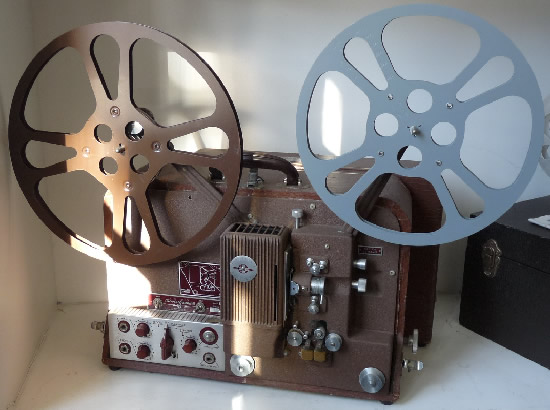
We have it on display in our shop along with the Cirse and Fairchild.
Posted by Robert Crewdson (Member # 3790) on January 13, 2018, 07:06 AM:
Buck, I have received several photos of the Eumig S709 that show the marking on the case for the loops of Super and Regular 8, the second photo shows the loop of a regular 8 film. I hope this answers your question.

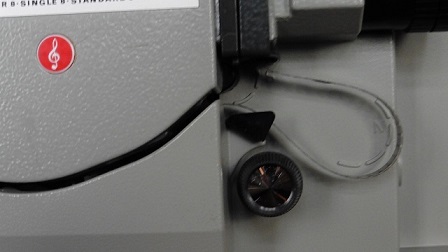
Posted by Osi Osgood (Member # 424) on January 13, 2018, 11:26 AM:
Neat projector Buck! Very needful for long features like, "Birth of a Nation" ![[Smile]](smile.gif)
Posted by Panayotis A. Carayannis (Member # 1220) on January 13, 2018, 04:14 PM:
Dominique- sound came to 8 mm in 1960.The tri-gauge Heurtiers had sound for 9-5 and 16. It is in 1959 that the problems of applying a sound stripe to the narrow 8mm film were solved and projectors started appearing.If Heurtier added soundheads for standard 8 in their three gauge projectors,this would be after 1960.In the beginning,they manifactured a separate amplifier and a big heavy soundhead designed so that the silent projector and the soundhead sat/fit on the amplifier.Their later projectors were of course in one piece. When the first std/super projectors were made,manifacturers did advice buyers that standard 8 would not play in sync with the sound.When Eumig manifactured a second gate with the longer lower part so that the film made a longer loop of 56 frames everything became ok.
Osi- I know that 8mm has been around since the thirties but we are talking about sound 8mm here!
Posted by Dominique De Bast (Member # 3798) on January 13, 2018, 05:19 PM:
Thanks for those precisions, Panayotis. As said before, there are few informations about that on the net.
Posted by Charles Peich (Member # 3791) on January 14, 2018, 09:42 AM:
Buck, congratulations on owning the Movie-Mite/Calvin, Cirse and Fairchild Reg 8 magnetic sound projectors! I have the Fairchild projector in my collection. Actually, when I was a kid I had the Fairchild system - camera and projector. I also had some Castle Films Reg 8 sound films. They were the Reg 8 versions of Castle's 16mm sound films, the ones that were on the 400ft 16mm reels.
Some time ago while researching the history of 16mm mag sound, I ran across this article about the Movie-Mite / Calvin 8mm mag projector. The one you have. I do recall seeing this projector at the Calvin facility in Kansas City, MO.
This article was published in August 1952 and was written by the Chief Engineer of Movie-Mite. I believe this was the 1st Reg 8 mag sound projector with playback and recording abilities designed from the ground up to make it to the market in the USA. Or, at least the 1st with a large reel capacity.
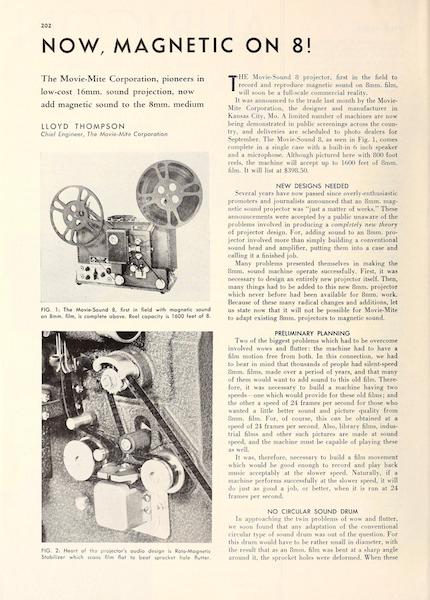
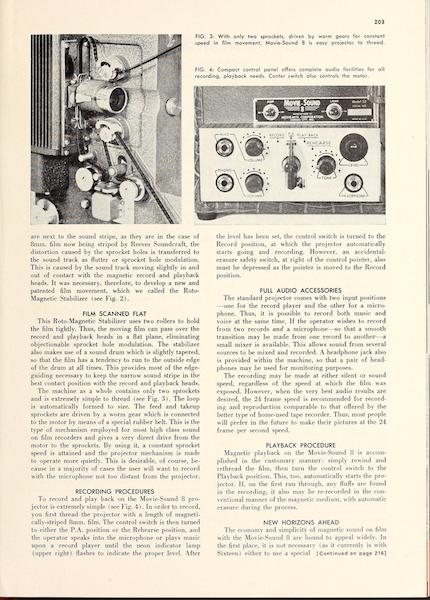
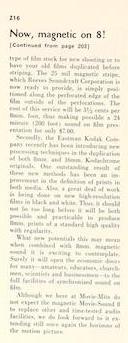
Forum, if these pics don't enlarge well enough to read, PM me and I'll send you my original files.
Or, this is the link to the article:
https://archive.org/details/moviemakers27amat
go to page 202.
Posted by Tom Photiou (Member # 130) on January 14, 2018, 10:00 AM:
Have to say Robert, my Brother bought an 810D HQS back in 74, no problems with loading standard 8 but we did have awful trouble with the machine slowing down to a virtual stand still halfway through a reel, it was sent back to Hendersons time and time again. In the end the guy in the shop we bought it in Plymouth told us to take it back in so he could see the fault himself, after at least four returns from the warranty repair, (a six week wait with each return), the local shop guy finally saw the fault, sent it off, and guess what? It came back with same fault!!!
They eventually gave us a new machine, in this day and age we wouldn't have to wait for such poor service before it was put right but it did put me off Eumigs for life. My Brother swears by them, and i do admit they are very kind to film and do have excellent sound quality, if you can put up with the hum.
Standard 8 films is what we started on but never had that many sound films, a couple of features and a couple of L & Hardys and a few other shorts but thats it. The image quality was always very good as was the sound. One of our feature films was a Robert Stack western called Great day in the morning, the image was unbelievable, it looked like a Technicolour film, it was that good, regretfully the sound sound was awful and muffled in places, never seen this film for sale since. ![[Wink]](wink.gif)
Posted by Robert Crewdson (Member # 3790) on January 14, 2018, 10:40 AM:
Hi Tom, I bought mine in 75, and only had to replace the sound head which seemed to cost half the price of the projector. The only thing I don't like is that the head comes into contact with silent film, and as I had more silent film for a time, it put wear on the head. I think on later models you could project films without the head coming into contact. A friend of mine at the time bought an earlier Eumig model and the soundhead was still in position when the machine was put into reverse; with the 810D it was lifted from the film. Other than that I have had no problems whatsoever. In the cold weather it used to run slowly to begin with then gradually picked up speed.
Posted by Paul Adsett (Member # 25) on January 14, 2018, 11:08 AM:
Charles, thank's for posting that most interesting article. I had no idea that 8mm mag stripe projectors went all the way back to 1952. In Europe they did not appear until the late 50's, so the US companies like Calvin and Fairchild were way ahead of the game.
Posted by Panayotis A. Carayannis (Member # 1220) on January 15, 2018, 11:45 AM:
I admit it is the first time I lerned that 8mm sound was announced in 1952 in America. However the 1953 volume does not mention anything new and unfortunately it is the most recent scanned. I would be interested to read from later consecutive years.
Posted by Buck Bito (Member # 2676) on January 15, 2018, 06:48 PM:
Hi Charles,
Thank you so much for posting that article above.
quote:
This article was published in August 1952 and was written by the Chief Engineer of Movie-Mite. I believe this was the 1st Reg 8 mag sound projector with playback and recording abilities designed from the ground up to make it to the market in the USA. Or, at least the 1st with a large reel capacity.
I have had no manual for my Calvin and it's great to have a photograph of the threading to confirm my assumptions. I was reluctant to trust my threading because it provides 44 and 49 frame offsets from the gate. I provide two offsets because my model has 2 mag heads where I assume the first (rear) is Record at 44 frames and the second (front) is Playback at 49 frames. So neither head is at what was adopted as standard 8mm magnetic sound offset (56 frames) using that threading pattern.
Posted by Thomas Dafnides (Member # 1851) on January 27, 2018, 11:45 PM:
Here is a youtube video of a 1959 Fairchild projector in action....runs & sounds great...
https://www.youtube.com/watch?v=xkulpe1LUoA
Posted by Paul Adsett (Member # 25) on January 28, 2018, 10:18 AM:
What a beauty! You've got to love the design of this machine. ![[Smile]](smile.gif)
Posted by Panayotis A. Carayannis (Member # 1220) on January 28, 2018, 12:14 PM:
I still would like to see catalogues or ads for pre-1959 sound-on-film 8mm films!
Visit www.film-tech.com for free equipment manual downloads. Copyright 2003-2019 Film-Tech Cinema Systems LLC

UBB.classicTM
6.3.1.2





![[Smile]](smile.gif)



![[Wink]](wink.gif)
![[Smile]](smile.gif)